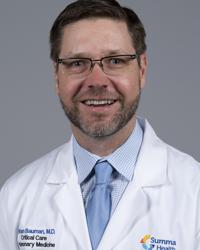What is a Lung Nodule?
Posted August 15, 2018 by Brian Bauman, MD

Lung nodules are abnormal clusters of tissue that appear as “spots” on chest X-rays and CT scans. All lung cancers starts as a nodule; however, these spots are very common and almost 95 percent of them are not cancerous.
Lung cancer is a very tragic disease. It has the lowest 5-year survival rate of all cancers and leads to more deaths that the next 3 deadliest cancers (colorectal, pancreatic and breast) combined.
Most lung cancers are not diagnosed and treated at an early stage, contributing to the low survival rate. However, early detection, by low-dose CT screening, can increase that rate by up to 20 percent in high-risk patients.
While any spots on the lungs can be alarming, nodules are so common that they appear on one in about every 500 X-rays. Lung nodules usually cause no symptoms. That is why they are almost always found accidentally on an X-ray or CT scan.
A few signs of malignant (cancerous) vs benign (noncancerous) lung nodules include:
- Size: The majority of nodules range from 0.2 inches to 1.2 inches. A nodule larger than 1.2 inches is more likely to be cancerous than a smaller one. The shape can also play a factor. The more irregularly shaped the nodule is, the more likely it could be cancer.
- Age: If you are younger than 40, the nodule(s) has a greater chance of being benign.
- Smoking: If you are a smoker and your primary care physician discovers nodules, you may want to consult an expert and get a low-dose CT screening.
- Location: Nodules found in the upper portions of the lung are more likely to be cancerous.
If it’s not cancer, what is it?
- It’s just not cancerous, yet. If you don’t have any risk factors associated with smoking, age or the size of the growth, your primary care physician may just want to watch and assess. Generally speaking, malignant nodules grow fast, usually doubling in size in just six months. Nodules that grow slower are less likely to be cancerous.
- Inflammation in the lung resulting from an infection or disease. An infectious fungus, a lung abscess and even tuberculosis can cause nodules in the lungs.
- Inflammation from noninfectious diseases like rheumatoid arthritis can cause lung nodules.
Because all lung cancers start as a nodule, the challenge is determining which nodules are or will become cancer. Some nodules may only require surveillance and routine follow-ups by a specialist, while others may require something more invasive, like a biopsy.
If it is malignant, there are also a variety of things it could be related to, including:
- Lung cancer
- Carcinoid, a small, slow-growing tumor
- Lymphoma, a growth that contains lymphoid tissue
- Tumors that have spread from cancer in another part of the body
- Sarcoma, a tumor containing connective tissue
If a nodule is discovered during an X-ray, your doctor may recommend a CT scan. CT (or CAT) scans are special tests that produce cross-sectional images of the body using X-rays and a computer. These specific types of scans can give more information on the nodule, including its size, shape and exact location.
Early detection is crucial to achieving the best outcomes. Evidence shows that screening with low-dose CT scans can reduce lung cancer mortality risk in individuals who have smoked 30 pack-years or more. A pack-year refers to the number of cigarettes smoked per day, per year over a period of time.
Summa Health has developed a specialized Lung Nodule Clinic with a dedicated team of experts who can handle everything along the continuum of lung care, including: lung cancer screenings, rapid evaluation of nodules and a multidisciplinary approach to lung cancer treatment. For more information, call 330.375.7280 in Akron and 330.615.4126 in Barberton.
About the Author
Vitality eNews Sign Up
Receive the Summa Health eNewsletter for the latest health tips, advice and updates.


 Listen to this episode of the Healthy Vitals Podcast featuring
Listen to this episode of the Healthy Vitals Podcast featuring